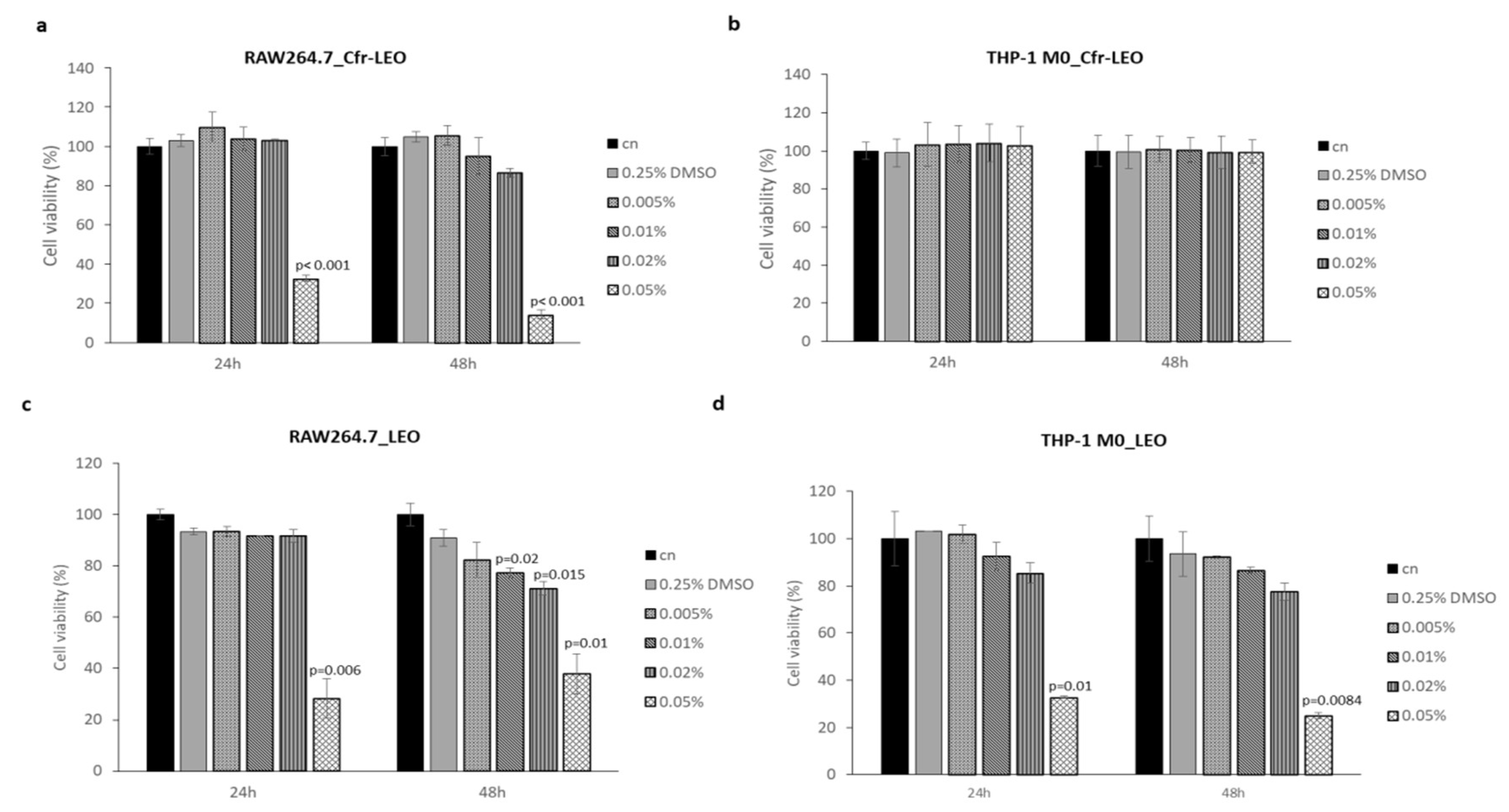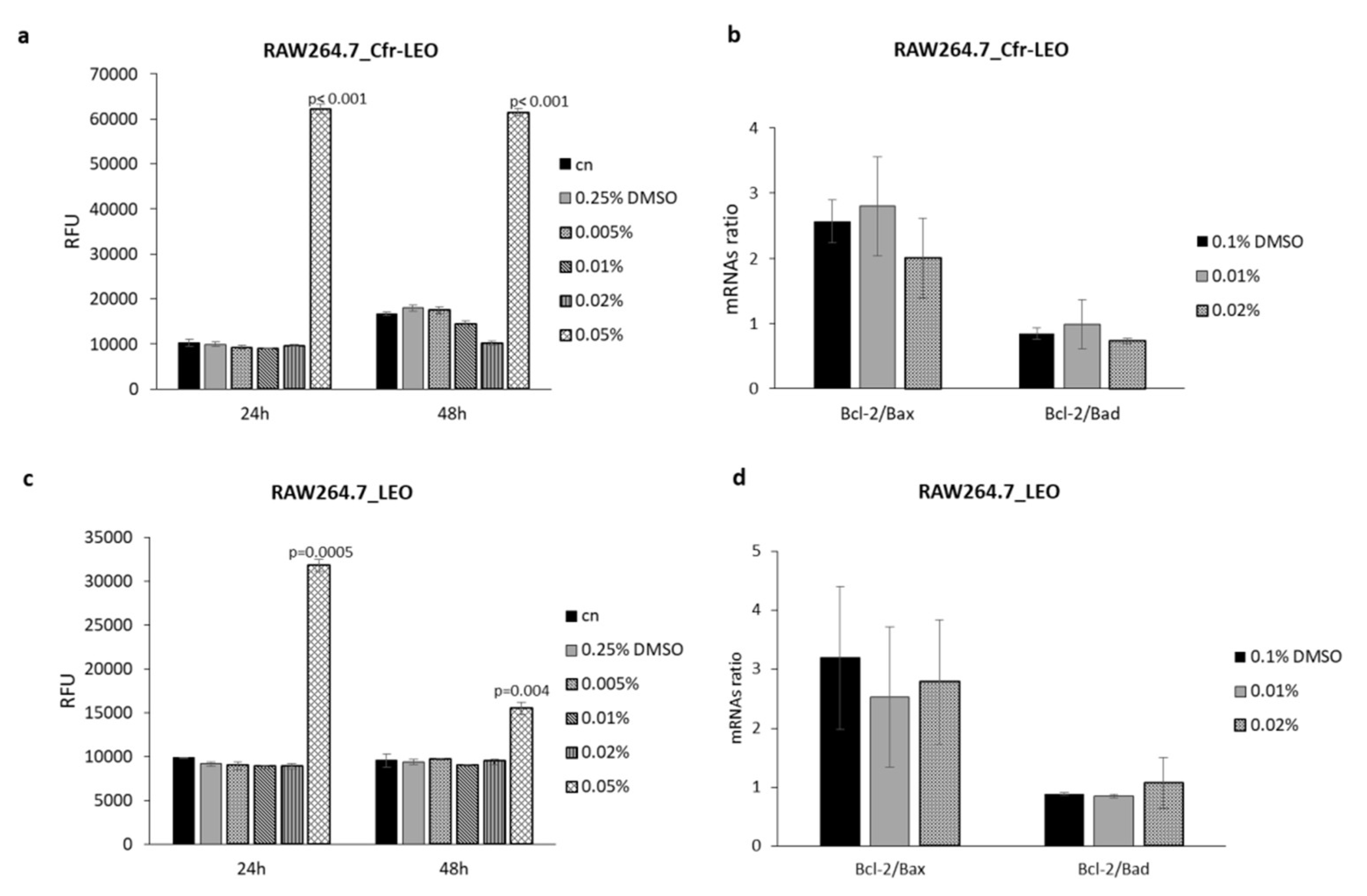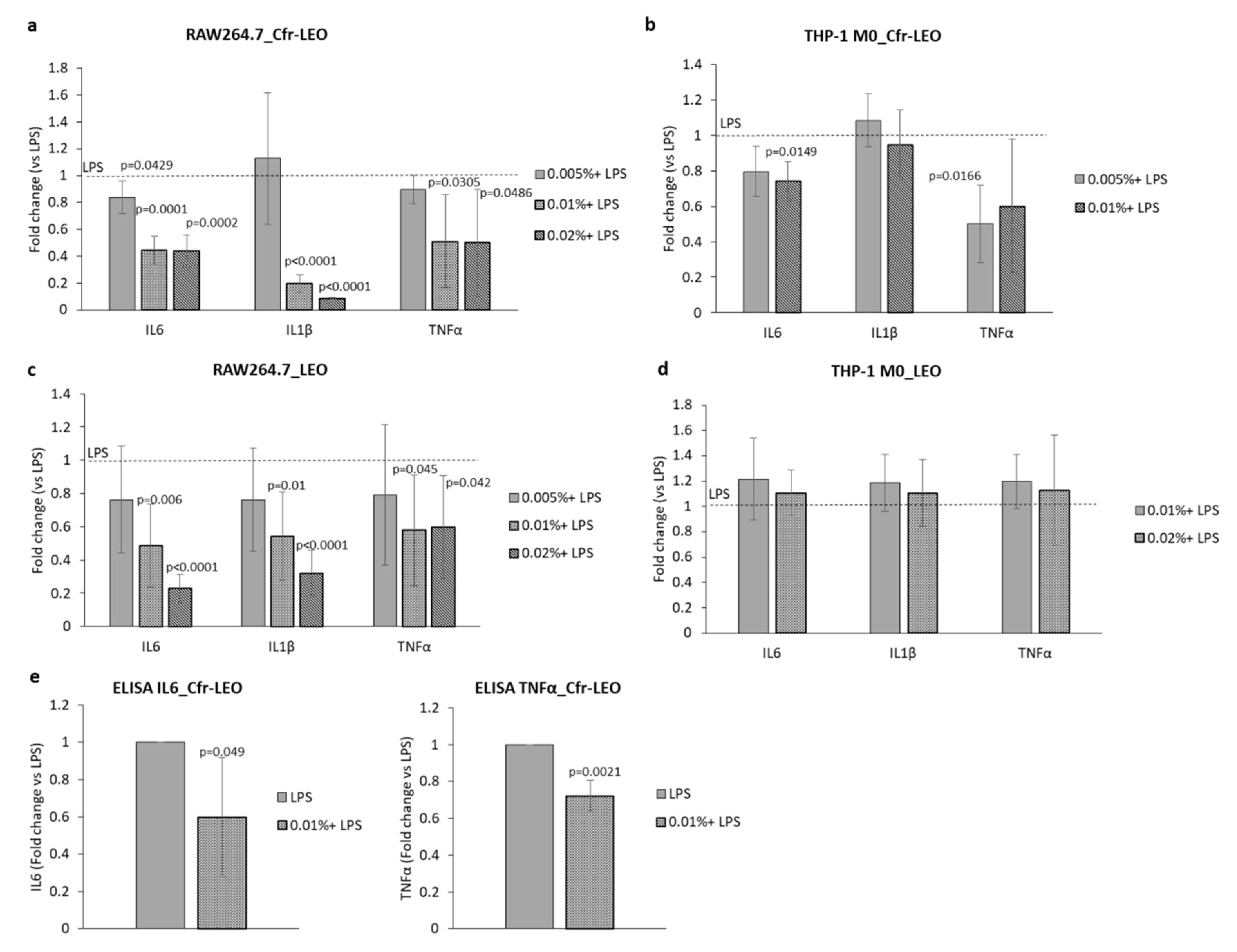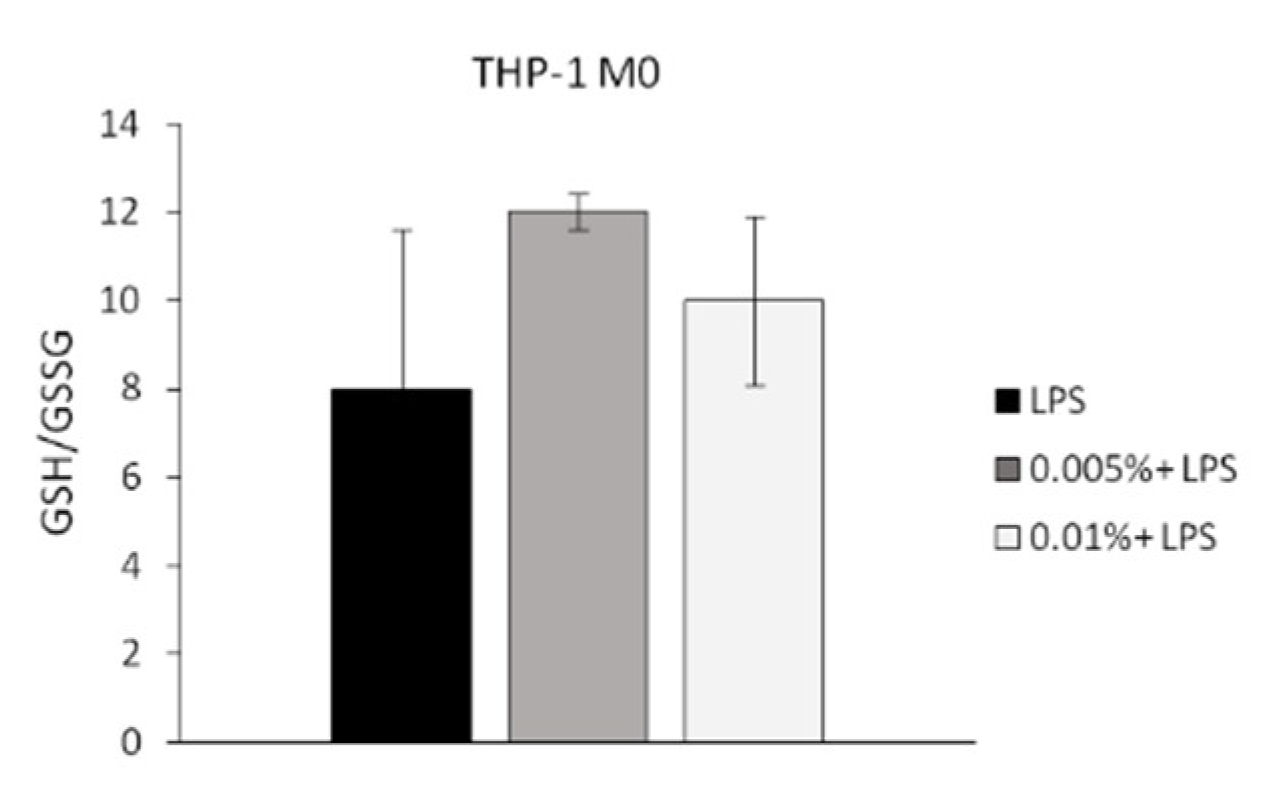Biological Properties of a Citral-Enriched Fraction of Citrus limon Essential Oil
Abstract
:1. Introduction
2. Materials and Methods
2.1. Purification of Enriched Fractions from Citrus limon L. Essential Oil
2.2. Gas Chromatography (GC-MS and GC-FID) Analyses
2.3. Cell Culture and Treatment
2.4. MTT (3-[4,5-Dimethylthiazol-2-yl]-2,5 Diphenyl Tetrazolium Bromide) Assay
2.5. Measurement of Cytotoxicity in Cells Exposed to Cfr-LEO Treatment
2.6. RNA Isolation and Real-Time PCR
2.7. Enzyme Linked ImmunoSorbent Assay (ELISA) Assays
2.8. Measurement of GSH and GSSG in Cells Exposed to Cfr-LEO Treatment
2.9. Statistical Analysis
3. Results and Discussion
3.1. Characterization of the Fractions Isolated from Citrus limon EO
3.2. Evaluation of Macrophage Cell Viability after Cfr-LEO Exposure
3.3. Evaluation of Macrophage Cytotoxicity after EO Exposure
3.4. Protective Effects of Cfr-LEO on LPS-Activated Macrophages
4. Conclusions
Supplementary Materials
Author Contributions
Funding
Conflicts of Interest
References
- Tongnuanchan, P.; Benjakul, S. Essential oils: Extraction, bioactivities, and their uses for food preservation. J. Food Sci. 2014, 79, R1231–R1249. [Google Scholar] [CrossRef]
- Jeliazkova, E.; Zheljazkov, V.D.; Kacaniova, M.; Astatkie, T.; Tekwani, B.L. Sequential elution of essential oil constituents during steam distillation of hops (humulus lupulus l.) and influence on oil yield and antimicrobial activity. J. Oleo Sci. 2018, 67, 871–883. [Google Scholar] [CrossRef] [PubMed] [Green Version]
- Celano, R.; Piccinelli, A.L.; Pagano, I.; Roscigno, G.; Campone, L.; De Falco, E.; Russo, M.; Rastrelli, L. Oil distillation wastewaters from aromatic herbs as new natural source of antioxidant compounds. Food Res. Int. 2017, 99, 298–307. [Google Scholar] [CrossRef] [PubMed]
- Klimek-Szczykutowicz, M.; Szopa, A.; Ekiert, H. Citrus limon (lemon) phenomenon-a review of the chemistry, pharmacological properties, applications in the modern pharmaceutical, food, and cosmetics industries, and biotechnological studies. Plants 2020, 9, 119. [Google Scholar] [CrossRef] [Green Version]
- Russo, M.; Bonaccorsi, I.; Costa, R.; Trozzi, A.; Dugo, P.; Mondello, L. Reduced time hplc analyses for fast quality control of citrus essential oils. J. Essent. Oil Res. 2015, 27, 307–315. [Google Scholar] [CrossRef]
- Kaskoos, R.A. Essential oil analysis by gc-ms and analgesic activity of lippia citriodora and citrus limon. J. Essent. Oil Bear. Plants 2019, 22, 273–281. [Google Scholar] [CrossRef]
- Gonzalez-Molina, E.; Dominguez-Perles, R.; Moreno, D.A.; Garcia-Viguera, C. Natural bioactive compounds of citrus limon for food and health. J. Pharm. Biomed. Anal. 2010, 51, 327–345. [Google Scholar] [CrossRef]
- Gamarra, F.M.C.; Sakanaka, L.S.; Tambourgi, E.B.; Cabral, F.A. Influence on the quality of essential lemon (citrus aurantifolia) oil by distillation process. Braz. J. Chem. Eng. 2006, 23, 147–151. [Google Scholar] [CrossRef]
- Luyendyk, J.P.; Kassel, K.M.; Allen, K.; Guo, G.L.; Li, G.; Cantor, G.H.; Copple, B.L. Fibrinogen deficiency increases liver injury and early growth response-1 (egr-1) expression in a model of chronic xenobiotic-induced cholestasis. Am. J. Pathol. 2011, 178, 1117–1125. [Google Scholar] [CrossRef]
- Hirota, R.; Roger, N.N.; Nakamura, H.; Song, H.S.; Sawamura, M.; Suganuma, N. Anti-inflammatory effects of limonene from yuzu (citrus junos tanaka) essential oil on eosinophils. J. Food Sci. 2010, 75, H87–H92. [Google Scholar] [CrossRef]
- Peana, A.T.; Rubattu, P.; Piga, G.G.; Fumagalli, S.; Boatto, G.; Pippia, P.; De Montis, M.G. Involvement of adenosine a1 and a2a receptors in (-)-linalool-induced antinociception. Life Sci. 2006, 78, 2471–2474. [Google Scholar] [CrossRef] [PubMed]
- Baik, J.S.; Kim, S.S.; Lee, J.A.; Oh, T.H.; Kim, J.Y.; Lee, N.H.; Hyun, C.G. Chemical composition and biological activities of essential oils extracted from korean endemic citrus species. J. Microbiol. Biotechnol. 2008, 18, 74–79. [Google Scholar] [PubMed]
- Katsukawa, M.; Nakata, R.; Takizawa, Y.; Hori, K.; Takahashi, S.; Inoue, H. Citral, a component of lemongrass oil, activates pparalpha and gamma and suppresses cox-2 expression. Biochim. Biophys. Acta 2010, 1801, 1214–1220. [Google Scholar] [CrossRef] [PubMed]
- Bouzenna, H.; Hfaiedh, N.; Giroux-Metges, M.A.; Elfeki, A.; Talarmin, H. Biological properties of citral and its potential protective effects against cytotoxicity caused by aspirin in the iec-6 cells. Biomed. Pharmacother. 2017, 87, 653–660. [Google Scholar] [CrossRef] [PubMed]
- Bhalla, Y.; Gupta, V.K.; Jaitak, V. Anticancer activity of essential oils: A review. J. Sci. Food Agric. 2013, 93, 3643–3653. [Google Scholar] [CrossRef]
- Puatanachokchai, R.; Kishida, H.; Denda, A.; Murata, N.; Konishi, Y.; Vinitketkumnuen, U.; Nakae, D. Inhibitory effects of lemon grass (cymbopogon citratus, stapf) extract on the early phase of hepatocarcinogenesis after initiation with diethylnitrosamine in male fischer 344 rats. Cancer Lett. 2002, 183, 9–15. [Google Scholar] [CrossRef]
- Balusamy, S.R.; Perumalsamy, H.; Veerappan, K.; Huq, M.A.; Rajeshkumar, S.; Lakshmi, T.; Kim, Y.J. Citral induced apoptosis through modulation of key genes involved in fatty acid biosynthesis in human prostate cancer cells: In silico and in vitro study. Biomed. Res. Int. 2020, 2020, 6040727. [Google Scholar] [CrossRef] [Green Version]
- Moreno-Macias, H.; Romieu, I. Effects of antioxidant supplements and nutrients on patients with asthma and allergies. J. Allergy Clin. Immunol. 2014, 133, 1237–1244, Quiz 1245. [Google Scholar] [CrossRef]
- Van Dyke, T.E.; van Winkelhoff, A.J. Infection and inflammatory mechanisms. J. Clin. Periodontol. 2013, 40 (Suppl. S14), S1–S7. [Google Scholar]
- Yoon, W.J.; Lee, N.H.; Hyun, C.G. Limonene suppresses lipopolysaccharide-induced production of nitric oxide, prostaglandin e2, and pro-inflammatory cytokines in raw 264.7 macrophages. J. Oleo Sci. 2010, 59, 415–421. [Google Scholar] [CrossRef] [Green Version]
- Shen, C.Y.; Jiang, J.G.; Zhu, W.; Ou-Yang, Q. Anti-inflammatory effect of essential oil from citrus aurantium l. Var. Amara engl. J. Agric. Food Chem. 2017, 65, 8586–8594. [Google Scholar] [CrossRef] [PubMed]
- Amorim, J.L.; Simas, D.L.; Pinheiro, M.M.; Moreno, D.S.; Alviano, C.S.; da Silva, A.J.; Fernandes, P.D. Anti-inflammatory properties and chemical characterization of the essential oils of four citrus species. PLoS ONE 2016, 11, e0153643. [Google Scholar] [CrossRef] [PubMed] [Green Version]
- Ben Hsouna, A.; Gargouri, M.; Dhifi, W.; Ben Saad, R.; Sayahi, N.; Mnif, W.; Saibi, W. Potential anti-inflammatory and antioxidant effects of citrus aurantium essential oil against carbon tetrachloride-mediated hepatotoxicity: A biochemical, molecular and histopathological changes in adult rats. Environ. Toxicol. 2019, 34, 388–400. [Google Scholar] [CrossRef] [PubMed]
- Bouzenna, H.; Samout, N.; Dhibi, S.; Mbarki, S.; Akermi, S.; Khdhiri, A.; Elfeki, A.; Hfaiedh, N. Protective effect of essential oil from citrus limon against aspirin-induced toxicity in rats. Hum. Exp. Toxicol. 2019, 38, 499–509. [Google Scholar] [CrossRef]
- Wang, L.; Zhang, Y.; Fan, G.; Ren, J.N.; Zhang, L.L.; Pan, S.Y. Effects of orange essential oil on intestinal microflora in mice. J. Sci. Food Agric. 2019, 99, 4019–4028. [Google Scholar] [CrossRef]
- Moraes, T.M.; Rozza, A.L.; Kushima, H.; Pellizzon, C.H.; Rocha, L.R.; Hiruma-Lima, C.A. Healing actions of essential oils from citrus aurantium and d-limonene in the gastric mucosa: The roles of vegf, pcna, and cox-2 in cell proliferation. J. Med. Food 2013, 16, 1162–1167. [Google Scholar] [CrossRef]
- Kang, P.; Suh, S.H.; Min, S.S.; Seol, G.H. The essential oil of citrus bergamia risso induces vasorelaxation of the mouse aorta by activating k(+) channels and inhibiting ca(2+) influx. J. Pharm. Pharmacol. 2013, 65, 745–749. [Google Scholar] [CrossRef]
- Kang, P.; Ryu, K.H.; Lee, J.M.; Kim, H.K.; Seol, G.H. Endothelium- and smooth muscle-dependent vasodilator effects of citrus aurantium l. Var. Amara: Focus on ca(2+) modulation. Biomed. Pharmacother. 2016, 82, 467–471. [Google Scholar] [CrossRef]
- Oboh, G.; Olasehinde, T.A.; Ademosun, A.O. Essential oil from lemon peels inhibit key enzymes linked to neurodegenerative conditions and pro-oxidant induced lipid peroxidation. J. Oleo Sci. 2014, 63, 373–381. [Google Scholar] [CrossRef] [Green Version]
- Costa, C.A.; Cury, T.C.; Cassettari, B.O.; Takahira, R.K.; Florio, J.C.; Costa, M. Citrus aurantium l. Essential oil exhibits anxiolytic-like activity mediated by 5-ht(1a)-receptors and reduces cholesterol after repeated oral treatment. BMC Complement. Altern. Med. 2013, 13, 42. [Google Scholar] [CrossRef]
- Zhang, L.L.; Yang, Z.Y.; Fan, G.; Ren, J.N.; Yin, K.J.; Pan, S.Y. Antidepressant-like effect of citrus sinensis (l.) osbeck essential oil and its main component limonene on mice. J. Agric. Food Chem. 2019, 67, 13817–13828. [Google Scholar] [CrossRef] [PubMed]
- Frolova, N.; Ukrainets, A.; Sylka, I.; Nemirich, A.; Kuzmin, O. Separation of terpenes from lemon essential oil by selective fractionation under a vacuum. East. Eur. J. Enterp. Technol. 2019, 2, 32–36. [Google Scholar] [CrossRef] [Green Version]
- Warsito, W.; Palungan, M.H.; Utomo, E.P. Profiling study of the major and minor components of kaffir lime oil (citrus hystrix dc.) in the fractional distillation process. Pan Afr. Med. J. 2017, 27, 282. [Google Scholar] [CrossRef] [PubMed]
- Kapsaski-Kanelli, V.N.; Evergetis, E.; Michaelakis, A.; Papachristos, D.P.; Myrtsi, E.D.; Koulocheri, S.D.; Haroutounian, S.A. “Gold” pressed essential oil: An essay on the volatile fragment from citrus juice industry by-products chemistry and bioactivity. Biomed. Res. Int. 2017, 2017, 2761461. [Google Scholar] [CrossRef] [PubMed] [Green Version]
- Mehl, F.; Marti, G.; Boccard, J.; Debrus, B.; Merle, P.; Delort, E.; Baroux, L.; Raymo, V.; Velazco, M.I.; Sommer, H.; et al. Differentiation of lemon essential oil based on volatile and non-volatile fractions with various analytical techniques: A metabolomic approach. Food Chem. 2014, 143, 325–335. [Google Scholar] [CrossRef] [PubMed]
- Dugo, P.; Ragonese, C.; Russo, M.; Sciarrone, D.; Santi, L.; Cotroneo, A.; Mondello, L. Sicilian lemon oil: Composition of volatile and oxygen heterocyclic fractions and enantiomeric distribution of volatile components. J. Sep. Sci. 2010, 33, 3374–3385. [Google Scholar] [CrossRef]
- Lu, Q.; Huang, N.; Peng, Y.; Zhu, C.; Pan, S. Peel oils from three citrus species: Volatile constituents, antioxidant activities and related contributions of individual components. J. Food Sci. Technol. 2019, 56, 4492–4502. [Google Scholar] [CrossRef]
- Navarra, M.; Ferlazzo, N.; Cirmi, S.; Trapasso, E.; Bramanti, P.; Lombardo, G.E.; Minciullo, P.L.; Calapai, G.; Gangemi, S. Effects of bergamot essential oil and its extractive fractions on sh-sy5y human neuroblastoma cell growth. J. Pharm. Pharmacol. 2015, 67, 1042–1053. [Google Scholar] [CrossRef]
- Hu, W.; Zhang, N.; Chen, H.; Zhong, B.; Yang, A.; Kuang, F.; Ouyang, Z.; Chun, J. Fumigant activity of sweet orange essential oil fractions against red imported fire ants (hymenoptera: Formicidae). J. Econ. Entomol. 2017, 110, 1556–1562. [Google Scholar] [CrossRef]
- Shiratori, H.; Feinweber, C.; Luckhardt, S.; Linke, B.; Resch, E.; Geisslinger, G.; Weigert, A.; Parnham, M.J. Thp-1 and human peripheral blood mononuclear cell-derived macrophages differ in their capacity to polarize in vitro. Mol. Immunol. 2017, 88, 58–68. [Google Scholar] [CrossRef]
- Raimondo, S.; Naselli, F.; Fontana, S.; Monteleone, F.; Lo Dico, A.; Saieva, L.; Zito, G.; Flugy, A.; Manno, M.; Di Bella, M.A.; et al. Citrus limon-derived nanovesicles inhibit cancer cell proliferation and suppress cml xenograft growth by inducing trail-mediated cell death. Oncotarget 2015, 6, 19514–19527. [Google Scholar] [CrossRef] [PubMed] [Green Version]
- Danial, N.N. Bcl-2 family proteins: Critical checkpoints of apoptotic cell death. Clin. Cancer Res. 2007, 13, 7254–7263. [Google Scholar] [CrossRef] [PubMed] [Green Version]
- Rea, I.M.; Gibson, D.S.; McGilligan, V.; McNerlan, S.E.; Alexander, H.D.; Ross, O.A. Age and age-related diseases: Role of inflammation triggers and cytokines. Front. Immunol. 2018, 9, 586. [Google Scholar] [CrossRef]
- Chung, H.Y.; Kim, D.H.; Lee, E.K.; Chung, K.W.; Chung, S.; Lee, B.; Seo, A.Y.; Chung, J.H.; Jung, Y.S.; Im, E.; et al. Redefining chronic inflammation in aging and age-related diseases: Proposal of the senoinflammation concept. Aging Dis. 2019, 10, 367–382. [Google Scholar] [CrossRef] [PubMed] [Green Version]
- Aiello, A.; Farzaneh, F.; Candore, G.; Caruso, C.; Davinelli, S.; Gambino, C.M.; Ligotti, M.E.; Zareian, N.; Accardi, G. Immunosenescence and its hallmarks: How to oppose aging strategically? A review of potential options for therapeutic intervention. Front. Immunol. 2019, 10, 2247. [Google Scholar] [CrossRef] [Green Version]
- Xia, S.; Zhang, X.; Zheng, S.; Khanabdali, R.; Kalionis, B.; Wu, J.; Wan, W.; Tai, X. An update on inflamm-aging: Mechanisms, prevention, and treatment. J. Immunol. Res. 2016, 2016, 8426874. [Google Scholar] [CrossRef]
- Franceschi, C.; Bonafe, M.; Valensin, S.; Olivieri, F.; De Luca, M.; Ottaviani, E.; De Benedictis, G. Inflamm-aging. An evolutionary perspective on immunosenescence. Ann. NY Acad. Sci. 2000, 908, 244–254. [Google Scholar] [CrossRef]
- Plastina, P.; Apriantini, A.; Meijerink, J.; Witkamp, R.; Gabriele, B.; Fazio, A. In vitro anti-inflammatory and radical scavenging properties of chinotto (citrus myrtifolia raf.) essential oils. Nutrients 2018, 10, 783. [Google Scholar] [CrossRef] [Green Version]
- Kim, K.N.; Ko, Y.J.; Yang, H.M.; Ham, Y.M.; Roh, S.W.; Jeon, Y.J.; Ahn, G.; Kang, M.C.; Yoon, W.J.; Kim, D.; et al. Anti-inflammatory effect of essential oil and its constituents from fingered citron (citrus medica l. Var. Sarcodactylis) through blocking jnk, erk and nf-kappab signaling pathways in lps-activated raw 264.7 cells. Food Chem. Toxicol. 2013, 57, 126–131. [Google Scholar] [CrossRef]
- Kiefer, R.; Kieseier, B.C.; Stoll, G.; Hartung, H.P. The role of macrophages in immune-mediated damage to the peripheral nervous system. Prog. Neurobiol. 2001, 64, 109–127. [Google Scholar] [CrossRef]
- Mantovani, A.; Allavena, P.; Sica, A.; Balkwill, F. Cancer-related inflammation. Nature 2008, 454, 436–444. [Google Scholar] [CrossRef] [PubMed]
- Elinav, E.; Nowarski, R.; Thaiss, C.A.; Hu, B.; Jin, C.; Flavell, R.A. Inflammation-induced cancer: Crosstalk between tumours, immune cells and microorganisms. Nat. Rev. Cancer 2013, 13, 759–771. [Google Scholar] [CrossRef] [PubMed]
- Cannizzo, E.S.; Clement, C.C.; Sahu, R.; Follo, C.; Santambrogio, L. Oxidative stress, inflamm-aging and immunosenescence. J. Proteom. 2011, 74, 2313–2323. [Google Scholar] [CrossRef] [PubMed]
- Sheweita, S.A.; El-Hosseiny, L.S.; Nashashibi, M.A. Protective effects of essential oils as natural antioxidants against hepatotoxicity induced by cyclophosphamide in mice. PLoS ONE 2016, 11, e0165667. [Google Scholar] [CrossRef]
- Porres-Martinez, M.; Gonzalez-Burgos, E.; Carretero, M.E.; Gomez-Serranillos, M.P. Protective properties of salvia lavandulifolia vahl. Essential oil against oxidative stress-induced neuronal injury. Food Chem. Toxicol. 2015, 80, 154–162. [Google Scholar] [CrossRef]
- Ho, E.; Karimi Galougahi, K.; Liu, C.C.; Bhindi, R.; Figtree, G.A. Biological markers of oxidative stress: Applications to cardiovascular research and practice. Redox Biol. 2013, 1, 483–491. [Google Scholar] [CrossRef] [Green Version]
- Valko, M.; Leibfritz, D.; Moncol, J.; Cronin, M.T.; Mazur, M.; Telser, J. Free radicals and antioxidants in normal physiological functions and human disease. Int. J. Biochem. Cell Biol. 2007, 39, 44–84. [Google Scholar] [CrossRef]
- Balkrishna, A.; Solleti, S.K.; Singh, H.; Tomer, M.; Sharma, N.; Varshney, A. Calcio-herbal formulation, divya-swasari-ras, alleviates chronic inflammation and suppresses airway remodelling in mouse model of allergic asthma by modulating pro-inflammatory cytokine response. Biomed. Pharmacother. 2020, 126, 110063. [Google Scholar] [CrossRef]
- Sousa, M.S.B.; Holanda, I.M.S.; Monteiro, H.M.C.; Amancio-Dos-Santos, A. Antioxidant extract counteracts the effects of aging on cortical spreading depression and oxidative stress in the brain cortex. Acta Cir. Bras. 2018, 33, 472–482. [Google Scholar] [CrossRef] [Green Version]
- Ni, J.; Wang, Q.; Shah, F.A.; Liu, W.; Wang, D.; Huang, S.; Fu, S.; Wu, L. Exogenous melatonin confers cadmium tolerance by counterbalancing the hydrogen peroxide homeostasis in wheat seedlings. Molecules 2018, 23, 799. [Google Scholar] [CrossRef] [Green Version]





| Gene | Forward | Reverse |
|---|---|---|
| Murine | ||
| GAPDH | CCCAGAAGACTGTGGATGG | CAGATTGGGGGTAGGAACAC |
| BCL-2 | GGACTTGAAGTGCCATTGGT | AGCCCCTCTGTGACAGCTTA |
| BAX | CTGCAGAGGATGATTGCTGA | GATCAGCTCGGGCACTTTAG |
| BAD | GAGTCGCCACAGTTCGTACC | GGTCCCATCGCACCTAACG |
| IL6 | GAGGATACCACTCCCAACAGACC | AAGTGCATCATCGTTGTTCATACA |
| TNFα | CACGTCGTAGCAAACCACCAAGTGGA | TGGGAGTAGACAAGGTACAACCC |
| IL1β | CAACCAACAAGTGATATTCTCCATG | GATCCAACACTCTCCAGCTGCA |
| Human | ||
| GAPDH | ATGGGGAAGGTGAAGGTCG | GGGTCATTGATGGCAACAATAT |
| IL6 | GGTACATCCTCGACGGCATCT | GTGCCTCTTTGCTGCTTTCAC |
| TNFα | CCAGGCAGTCAGATCATCTTCTC | AGCTGGTTATCTCTCAGCTCCAC |
| IL1β | ACAGATGAAGTGCTCCTTCCA | GTCGGAGATTCGTAGCTGGAT |
| No | VOLATILE COMPOUND | WHOLE LEO | Fr13 | Fr14 | Fr15 | Fr16 | |||||
|---|---|---|---|---|---|---|---|---|---|---|---|
| Rt a | Area (%) b | Rt | Area (%) | Rt | Area (%) | Rt | Area (%) | Rt | Area (%) | ||
| 1 | α-Thujene | 1.688 | 0.43 | 1.674 | 0.42 | 1.676 | 0.42 | 1.675 | 0.42 | 1.675 | 0.42 |
| 2 | α-Pinene | 1.757 | 1.81 | 1.743 | 1.79 | 1.745 | 1.79 | 1.744 | 1.79 | 1.744 | 1.79 |
| 3 | Camphene | 1.892 | 0.06 | 1.875 | 0.05 | 1.878 | 0.06 | 1.876 | 0.05 | 1.877 | 0.05 |
| 4 | Sabinene | 2.132 | 1.83 | 2.112 | 1.81 | 2.115 | 1.81 | 2.113 | 1.81 | 2.114 | 1.81 |
| 5 | β-Pinene | 2.197 | 10.88 | 2.178 | 10.81 | 2.181 | 10.80 | 2.18 | 10.80 | 2.18 | 10.79 |
| 6 | Myrcene | 2.309 | 1.57 | 2.286 | 1.56 | 2.29 | 1.56 | 2.288 | 1.56 | 2.289 | 1.56 |
| 7 | Octanal | 2.447 | 0.07 | 2.419 | 0.06 | 2.422 | 0.06 | 2.419 | 0.06 | 2.421 | 0.06 |
| 8 | Phellandrene | 2.504 | 0.05 | 2.477 | 0.04 | 2.481 | 0.04 | 2.478 | 0.04 | 2.48 | 0.04 |
| 9 | δ-3-Carene | 2.593 | 0.01 | 2.566 | 0.01 | 2.572 | 0.01 | 2.57 | 0.01 | 2.571 | 0.01 |
| 10 | α-Terpinene | 2.683 | 0.21 | 2.654 | 0.20 | 2.661 | 0.20 | 2.657 | 0.20 | 2.657 | 0.20 |
| 11 | Limonene | 2.982 | 67.10 | 2.965 | 67.09 | 2.972 | 67.09 | 2.971 | 67.07 | 2.972 | 67.05 |
| 12 | (Z)- β-Ocimene | 3.063 | 0.05 | 3.008 | 0.05 | 3.014 | 0.05 | 3.012 | 0.05 | 3.013 | 0.05 |
| 13 | (E)- β-Ocimene | 3.198 | 0.12 | 3.163 | 0.12 | 3.17 | 0.12 | 3.166 | 0.12 | 3.168 | 0.12 |
| 14 | γ-Terpinene | 3.434 | 9.32 | 3.404 | 9.27 | 3.411 | 9.27 | 3.408 | 9.26 | 3.41 | 9.26 |
| 15 | Cis-Sabinene hydrate | 3.556 | 0.04 | 3.522 | 0.01 | 3.52 | 0.01 | 3.513 | 0.02 | 3.515 | 0.03 |
| 16 | Octanol | 3.654 | 0.01 | 3.612 | 0.00 | 3.609 | 0.00 | 3.606 | 0.00 | 3.608 | 0.00 |
| 17 | Terpinolene | 3.936 | 0.41 | 3.893 | 0.41 | 3.9 | 0.40 | 3.895 | 0.40 | 3.898 | 0.40 |
| 18 | Trans-Sabinene hydrate | 4.132 | 0.03 | 4.1 | - | 4.1 | - | 4.1 | - | 4.1 | - |
| 19 | Linalool | 4.158 | 0.13 | 4.109 | 0.13 | 4.115 | 0.14 | 4.109 | 0.15 | 4.112 | 0.15 |
| 20 | Nonanal | 4.228 | 0.11 | 4.179 | 0.11 | 4.185 | 0.10 | 4.18 | 0.10 | 4.183 | 0.10 |
| 21 | Citronellal | 5.186 | 0.10 | 5.134 | 0.10 | 5.14 | 0.10 | 5.134 | 0.10 | 5.137 | 0.10 |
| 22 | Terpinen-4-ol | 5.65 | 0.03 | 5.596 | 0.03 | 5.601 | 0.03 | 5.594 | 0.03 | 5.598 | 0.03 |
| 23 | α-Terpineol | 5.917 | 0.17 | 5.724 | - | 5.729 | 0.01 | 5.863 | 0.03 | 5.865 | 0.05 |
| 24 | Decanal | 6.223 | 0.04 | 6.171 | 0.03 | 6.177 | 0.03 | 6.17 | 0.03 | 6.174 | 0.03 |
| 25 | Nerol+Citronellol | 6.678 | 0.05 | 6.633 | 0.00 | 6.629 | 0.01 | 6.622 | 0.02 | 6.625 | 0.03 |
| 26 | Neral | 6.905 | 1.00 | 6.854 | 1.35 | 6.86 | 1.33 | 6.854 | 1.31 | 6.858 | 1.31 |
| 27 | Geraniol | 7.192 | 0.05 | 7.14 | - | 7.14 | - | 7.148 | - | 7.147 | 0.01 |
| 28 | Geranial | 7.483 | 1.72 | 7.435 | 2.19 | 7.442 | 2.21 | 7.437 | 2.21 | 7.44 | 2.21 |
| 29 | Undecanal | 8.15 | 0.02 | 8.096 | 0.02 | 8.102 | 0.02 | 8.096 | 0.02 | 8.1 | 0.02 |
| 30 | Methyl geranate | 8.682 | 0.02 | 8.628 | 0.03 | 8.634 | 0.03 | 8.628 | 0.03 | 8.632 | 0.03 |
| 31 | Citronellyl acetate | 9.006 | 0.03 | 8.951 | 0.03 | 8.956 | 0.03 | 8.951 | 0.03 | 8.955 | 0.03 |
| 32 | Neryl acetate | 9.203 | 0.46 | 9.15 | 0.51 | 9.155 | 0.49 | 9.15 | 0.49 | 9.154 | 0.48 |
| 33 | Geranyl acetate | 9.54 | 0.31 | 9.486 | 0.35 | 9.491 | 0.33 | 9.486 | 0.33 | 9.49 | 0.33 |
| 34 | β-Caryophyllene | 10.105 | 0.23 | 10.05 | 0.23 | 10.056 | 0.23 | 10.051 | 0.23 | 10.055 | 0.23 |
| 35 | Bergamotene | 10.409 | 0.31 | 10.357 | 0.32 | 10.362 | 0.31 | 10.357 | 0.32 | 10.361 | 0.32 |
| 36 | Valencene | 11.325 | 0.02 | 11.275 | 0.02 | 11.279 | 0.02 | 11.276 | 0.02 | 11.279 | 0.02 |
| 37 | Bicyclogermacrene | 11.374 | 0.05 | 11.325 | 0.04 | 11.328 | 0.05 | 11.325 | 0.04 | 11.328 | 0.04 |
| 38 | (Z)-α-Bisabolene | 11.475 | 0.05 | 11.432 | 0.04 | 11.435 | 0.04 | 11.432 | 0.04 | 11.435 | 0.04 |
| 39 | β-Bisabolene | 11.553 | 0.48 | 11.512 | 0.48 | 11.516 | 0.48 | 11.513 | 0.48 | 11.515 | 0.48 |
| 40 | γ-Elemene | 11.931 | 0.02 | 11.896 | 0.02 | 11.899 | 0.02 | 11.896 | 0.02 | 11.898 | 0.02 |
| 41 | 2-Norbornarol | 12.859 | 0.02 | 12.83 | 0.02 | 12.832 | 0.02 | 12.831 | 0.02 | 12.831 | 0.02 |
| 42 | Campherenol | 12.947 | 0.02 | 12.919 | 0.02 | 12.92 | 0.02 | 12.919 | 0.02 | 12.92 | 0.03 |
| 43 | Bisabolol | 13.046 | 0.02 | 13.02 | 0.03 | 13.02 | 0.03 | 13.02 | 0.03 | 13.02 | 0.03 |
| Chemical Classes | Whole LEO (%) | Fr 13 (%) | Fr 14 (%) | Fr 15 (%) | Fr 16 (%) |
|---|---|---|---|---|---|
| Monoterpenes | 93.9 | 93.65 | 93.64 | 93.61 | 93.6 |
| Total Aldehydes | 3.06 | 3.87 | 3.85 | 3.84 | 3.84 |
| citral (geranial + neral) | 2.73 (1.72 + 1) | 3.54 (2.19 + 1.35) | 3.53 (2.21 + 1.33) | 3.52 (2.21 + 1.31) | 3.52 (2.21 + 1.31) |
| Aldehydes minus citral | 0.33 | 0.33 | 0.32 | 0.32 | 0.32 |
| Sesquiterpenes | 1.16 | 1.15 | 1.15 | 1.15 | 1.15 |
| Esters | 0.82 | 0.92 | 0.88 | 0.87 | 0.87 |
| Aliphatic Alcohols | 0.43 | 0.17 | 0.20 | 0.24 | 0.28 |
| Sesquiterpene Alcohols | 0.06 | 0.07 | 0.07 | 0.07 | 0.07 |
© 2020 by the authors. Licensee MDPI, Basel, Switzerland. This article is an open access article distributed under the terms and conditions of the Creative Commons Attribution (CC BY) license (http://creativecommons.org/licenses/by/4.0/).
Share and Cite
Pucci, M.; Raimondo, S.; Zichittella, C.; Tinnirello, V.; Corleone, V.; Aiello, G.; Moschetti, M.; Conigliaro, A.; Fontana, S.; Alessandro, R. Biological Properties of a Citral-Enriched Fraction of Citrus limon Essential Oil. Foods 2020, 9, 1290. https://doi.org/10.3390/foods9091290
Pucci M, Raimondo S, Zichittella C, Tinnirello V, Corleone V, Aiello G, Moschetti M, Conigliaro A, Fontana S, Alessandro R. Biological Properties of a Citral-Enriched Fraction of Citrus limon Essential Oil. Foods. 2020; 9(9):1290. https://doi.org/10.3390/foods9091290
Chicago/Turabian StylePucci, Marzia, Stefania Raimondo, Chiara Zichittella, Vincenza Tinnirello, Valeria Corleone, Gioacchino Aiello, Marta Moschetti, Alice Conigliaro, Simona Fontana, and Riccardo Alessandro. 2020. "Biological Properties of a Citral-Enriched Fraction of Citrus limon Essential Oil" Foods 9, no. 9: 1290. https://doi.org/10.3390/foods9091290
APA StylePucci, M., Raimondo, S., Zichittella, C., Tinnirello, V., Corleone, V., Aiello, G., Moschetti, M., Conigliaro, A., Fontana, S., & Alessandro, R. (2020). Biological Properties of a Citral-Enriched Fraction of Citrus limon Essential Oil. Foods, 9(9), 1290. https://doi.org/10.3390/foods9091290








